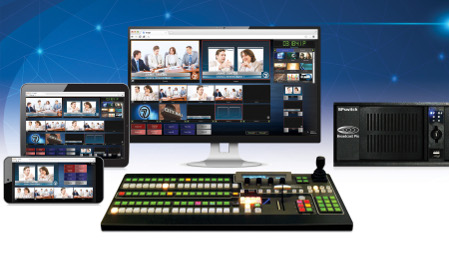Switchers on Steroids
SAN FRANCISCO—Think of it as a vital game of give and take.
On the one hand, M&E companies are demanding more efficient ways of capturing, managing and manipulating video from within their facility. And on the other, the industry has narrowed its focus on a key distribution technology—all in the name of allowing media companies to get video more efficiently to air.

Jim Robinson, sets up the Newtek NDI webserver. Note the multiple camera sources on the rear monitor.
Where is this game of expansion and contraction taking place? Most notably, within today’s modern integrated production systems (IPS). These control technologies have been modernized and streamlined in recent years so they can be customized quickly, operate more efficiently and more deftly control a greater number of third-party systems.
At the same time, the behind-the-scenes workhorse processing these machines—here enters IP networking—continues to bound forward as a key piece of tomorrow’s networking future.
Customers talking about automated production control, whether it be for studio production or live news, have a few demands. They want flexibility. They want to know that switcher they’re buying today supports IP. And they want to be able to scale their operations in ways that weren’t possible even a half dozen years ago.
And let’s not forget moving around the furniture.
SAVING SPACE
With IP, “because everything is interconnected, we don’t have the physical [confines] of space,” said Will Walters, director of product marketing for NewTek.
With IP networks, a broadcaster has the capability to dismantle parts of the traditional physical layout of a facility. Traditionally, control rooms were built close to where content is produced since video traditionally arrives in a router or cross point switch housed in the same rack.
IPS technologies with IP-backbone solutions allow a facility to string together elements in a single chain, or break them up as needed for a smaller crew. “It basically gives a station the ability to scale your production as necessary,” he said, such as when an integrated production system is being set up with three cameras for a talk show or as a larger multicamera shoot for a live sporting event.
Putting its integrated production system on the IP path was a priority for companies like The Weather Company. The group built new digital studios as part of the company’s new offices in Brookhaven, Ga. With a huge bevy of protocols and formats, depending on where the source was coming from, the firm was looking for a flexible technology that could handle micro reporting from individual sites, such as from cell phones or small kits in the field using cellular production. Weather is a changeable thing, and the company needed its acquisition process to keep pace. That’s when they turned to Newtek’s NDI protocol.
The facility now brings in a signal—from origination to delivery—that is nearly completely IP. They only use of SDI within the plant is for redundancy recording, Waters said.
IP-based integrated production systems offer flexibility and agility not found in other networking protocols, he said.
CONTROL ANYWHERE
That notion of improved flexibility is also being adopted by Broadcast Pix within its BPswitch integrated production switchers. Using the Broadcast Pix Commander interface, users can control the BPswitch switcher via a tablet, phone or laptop that’s operating as part of the BPNet IP ecosystem. This flexibility means users can create live productions from inside or out of a traditional facility.
“We’ve been behind IP since day one; now it’s moving us on to bigger things,” said Tony Mastantuono, product manager for the Chelmsford, Mass.-based company.

Broadcast Pix BPSwitch
“We’ve taken the idea of control anywhere in the world to the next level,” he said, as the technologies allow for command interfaces to be user-customizable for different types of workflows. For example, if an operator only needs a few cameras and a simple clip store for a live event, the system’s interface can be customized and controlled based on the type of production at hand.
“Traditionally you’d have cameras on a local system and the operator is local,” Mastantuono said. While that is still the norm, you now have these three parts—the engine, the cameras and the operator—that can be controlled in new ways. “The cameras can be in a government meeting location, while the actual engine can be in the studio, and through IP streaming, all those streams could be [distributed .]”
SIMPLIFYING PRODUCTION
For Grass Valley, one major focus is reducing complexities within IPS control. Another goal not far behind: ensuring that Grass Valley solutions are taking advantage of the efficiencies that IP connectivity has to offer.
“The hallmark for this year… is the notion of complexity,” said Chuck Garfield, director of news product management at Grass Valley.
While vendors have been known (once or twice) to say, “it’s so easy to use our system,” the reality can be different. It’s not always simple to effectively train and maintain staff knowledge of a system, particularly over the long term.
Reversing that notion is a priority for the company.
“Reducing complexity means we are creating a new set of tools for the Ignite [automated production control solution] and allow us to control our event library—to allow a nontechnical person to change the library, change cameras being used in each shot, etc.,” he said.
“That reduces the amount of training time [before] deploying a system; it reduces the amount of time it takes to handle last-minute changes that come in,” he said.
Improving complexity in the face of a fast-paced news environment is a key issue with customers, he said. “There is a big refresh happening in the industry with… automated production control room systems,” Garfield said. “And in most cases, it’s a complete forklift upgrade. They’re taking a fresh new upgrade [because] this notion of making an operator’s day-to-day life easier is one that’s really compelling.”
At the upcoming NAB show, the company plans to showcase a new IP workflow within the Ignite and K-Frame production systems, as “[customers] want to know that the switcher they’re buying today supports IP,” Garfield said. “Customers want flexibility where IP is concerned.”
Grass Valley also plans to announce third-party switcher support across some product lines. “More and more, we’ve got customers who like a [different] switcher workflow and they’ve asked us to integrate that.”
THE PROFESSIONAL LOOK
The industry is at the point in its evolution that media firms want to create and push out more content in an easier, more streamlined fashion.
“They want to cover more meetings and create more local programming, no matter what the market is,” Broadcast Pix’s Mastantuono said. “And more importantly, they don’t want to sacrifice the production aspect. That production value has to be there within an integrated production system. It has to integrate clips, graphics, automation and repackage for different audiences.”
Customers are also looking for single-operator simplicity.
“In a rapidly evolving marketplace where there is a plethora of ‘technology for technology’s sake,’ integrated systems can quickly overwhelm people with little television production experience,” said Rush Beesley, founder of RUSHWORKS.
Get the TV Tech Newsletter
The professional video industry's #1 source for news, trends and product and tech information. Sign up below.
Susan Ashworth is the former editor of TV Technology. In addition to her work covering the broadcast television industry, she has served as editor of two housing finance magazines and written about topics as varied as education, radio, chess, music and sports. Outside of her life as a writer, she recently served as president of a local nonprofit organization supporting girls in baseball.

